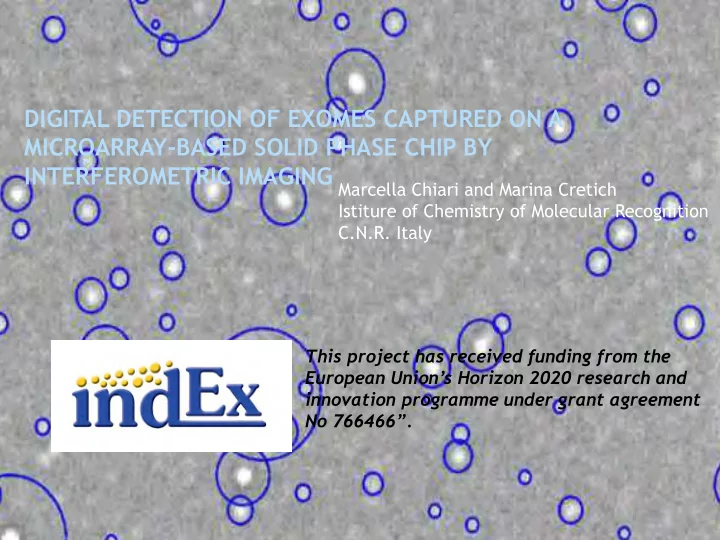

DIGITAL DETECTION OF EXOMES CAPTURED ON A MICROARRAY-BASED SOLID PHASE CHIP BY INTERFEROMETRIC IMAGING Marcella Chiari and Marina Cretich Istiture of Chemistry of Molecular Recognition C.N.R. Italy This project has received funding from the European Union’s Horizon 2020 research and innovation programme under grant agreement No 766466”.
http://journal.frontiersin.org/article/10.3389/fimmu.2015.00203/full
Hurdles in the clinical utilization of exosomes Lack of methods to isolate a pure exosome population • Difficulty in accurately measuring the quantity and purity of • exosomes. Exosomes have diameters in the range from 30-100 • nanometers, i.e., which is too small to be accurately sized by conventional methods such as optical microscopy and flow cytometry (FC) without labels.
INDEX: I ntegrated n anoparticle isolation and d etection system for complete on-chip analysis of ex osomes Horizon2020 Framework Programme, H2020-FETOPEN-2016-2017 (H2020-FETOPEN-1-2016-2017)
Prof. Selim Unlu Dr. George Daabaoul Boston University NexGen Array Boston Interferometric detection platforms IRIS SP-IRIS Single Particle Interferometric Reflectance Interferometric Reflectance Imaging Sensor Imaging Sensor
Label-free detection by LED based Interferometric Reflectance Imaging Sensor (IRIS) Spectral reflectance signature Daaboul GG… . and M. S. Ünlü Biosens Bioelectron 26 : 2221-2227 (2011 )
*
Single particle-IRIS A visible LED provides illumination and bright field reflection image is captured on a CCD camera. The key to improved visibility of nanoparticles on the SP-IRIS system is mixing of the scattered light with reference field reflected from the Si surface.
Single Particle – IRIS Single Virus Detection Single Molecule Detection of Antigen (label –free) proteins and DNA/RNA nano-barcode SiO 2 Si IRIS detection platform • Label Free direct sensing of individual viruses • Digital Detection: Single molecule level detection of Nucleic Acids and Proteins • ULTIMATE BIODETECTION PLATFORM?
Real-Time in-liquid Virus Detection
Single Particle Interferometric Reflectence Imaging Sensor SP-IRIS SP-IRIS detection principle, monochromatic LED light illuminates the sensor surface and the interferometricly enhanced nanoparticle scattering signature is captured on a CMOS camera.
Exosome capture, digital counting, and relative sizing. A-B) Anti-CD81 capture probe image acquired before and after incubation with purified Human Embryonic Kidney 293 (HEK293) cells derived exosomes. C-D) zoom-box of particles detected pre- and post-incubation. E-F) particle contrast histogram pre- and post-incubation
Nanoparticle capture validation with scanning electron microscope (SEM) A) SP-IRIS image of exosomes being captured by anti-CD81 antibody. B) Exosomes visualized by SEM of the same field-of-view for comparison. Scale bar is 1 micron.
Nanoparticle capture validation with AFM Exosomes purified from HEK cell line, captured with anti- CD81 antibody on silicon chip and detected by SP-IRIS (A) and AFM (B, C).
Phenotyping of exosomes from HEK cells Nanoparticle tracking analysis Exosomes, isolated from HEK cells and EV depleted supernatant, captured with antibodies against CD81, CD63, CD9 and IgG negative control and detected by SP-IRIS.
Contrast distribution of particles of HEK exosomes purified by ultracentrifugation Anti CD63 Anti CD81 U n r e l a t e d I g G (A,B,C) and EVs depleted supernatant (D,E,F) incubated on SP-IRIS chip with anti-CD63 (A,D), anti-CD81 (B,E) and Goat IgG negative control (C,F) spotted on the surface of the chip.
Dilution curve of exosomes purified from HEK cell line and detected with SP-IRIS . LOD= 3.94E+09 particles/mL LOD= 5.07E+09 particles/mL A good correlation can be observed for both capture antibodies CD63 (yellow line, R 2 0.97) and CD81 (blue line, R 2 0.93);
SP-IRIS label-free assay on human hydrocephalus CSF sample and artificial CSF. The expression of the typical exosomal biomarkers CD81 CD63 as well as the neural adhesion protein CD171 is significantly different than in the artificial CSF, negative control.
Reversible capture of exosomes exosomes are immunocaptured through DNA-directed Immobilization of exosome-specific antibodies ( Anti-CD9 and Anti-CD63 ).
Anti-CD9 antibody.
ACKNOWLEDGMENTS: ANALYTICAL MICROSYSTEM LAB Marina Cretich Francesco Damin Laura Sola PhD students and post docs Paola Gagni Dario Brambilla Boston University Selim Unlu NexGen Array George Doaboul, NexGen Array Istituto Centro San Giovanni di Dio Fatebenefratelli, Brescia, Italy Roberta Ghidoni, Luisa Benussi University of Trento, Povo (TN) Italy Paolo Bettotti Index Ready Amanda
Recommend
More recommend